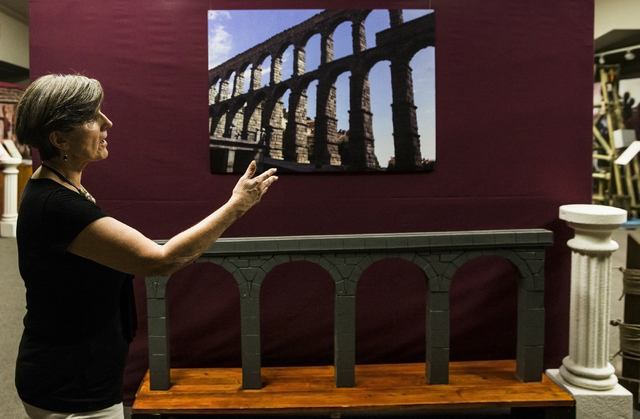Las Vegas museum provides glimpse of ancient Rome














All roads lead to Vegas — including ancient Rome’s.
In recent weeks, Caesars Palace has been trumpeting its ersatz empire with 50th-anniversary celebrations, from a red-carpet birthday bash to various statues sporting red anniversary sashes.
As an example of the latter, Caesar himself flaunts one out on the Strip. So does the replica of Michelangelo’s David (an interloper from Renaissance-era Florence), who’s otherwise letting it all hang out inside the Appian Way shopping arcade.
It’s not exactly surprising that the actual Appian Way (constructed in 312 B.C.) bore scant resemblance to the Caesars Palace version.
Discovering the difference doesn’t require extensive historical research, however.
All it takes is a visit to the Las Vegas Natural History Museum, where “Ancient Rome: The Empire That Shaped the World” provides a detailed glimpse of the real thing.
In keeping with Las Vegas’ Caesars-centric tendencies, the museum banner promoting the touring exhibit touts “Julius Caesar: Roman Military Might and Machines.”
Julius Caesar does indeed loom large throughout the exhibit, which highlights his status as “writer, inventor, strategist and military genius,” notes Marilyn Gillespie, the museum’s executive director.
As an example of Julius Caesar’s ingenuity, did you know that he paved the way for bound books when he told underlings to cut up scrolled maps and stack the pages? (The scrolls were too difficult to consult while the mighty Caesar was on horseback.)
And, much as we 21st-century types would use a dry-erase board, Romans used a tabula rasa — a wooden board covered with a layer of wax — to write and delete notes.
Students of history know that Julius Caesar expanded the Roman Republic through a series of battles across Europe before declaring himself dictator for life. (Which prompted several Roman senators to assassinate him 44 B.C.)
The exhibit helps visitors understand how he achieved his power with hand-crafted replicas of such machines of war as the one that helped Caesar and his 10,000 troops build a pontoon bridge and cross the Rhine River in 10 days.
A history professor featured in an accompanying video likens the feat to “almost as if a spaceship were to come down in New York” in the present day.
There’s a full-size battering ram — and a small model with which visitors can knock down blocks — along with a catapult called an onager, named for an Asian wild ass known for its powerful kick.
Curved, decorated shields arranged in a testudo (tortoise) formation illustrate how Roman legionnaires protected soldiers in battle.
Speaking of those Roman legions, the exhibit also explains the differences between the foot soldiers and the centurions who commanded them. One key difference: the horsehair or feathered crests topping the centurions’ helmets.
Which brings us to all those paintings of all those Roman officers adorning the Caesars Palace interior. They’ve got crested helmets, which must mean they’re centurions, but their red capes could be togas, which would make them members of the emperor’s own Praetorian Guard, introduced by Augustus Caesar. (Whose name happens to adorn a lobby and one of the Caesars Palace hotel towers.)
The museum exhibit also explores secrets of the original Roman Colosseum and the gladiators who fought there, armed with weapons ranging from the short, sized-for-stabbing sword known as a gladius (now we know where gladiators got their name) to dagger (pugio) and scimitar (sica).
As for Caesars Palace’s Colosseum, it’s a puny thing compared to the original, a genuinely ginormous amphitheater (formally named the Amphitheatrum Flavium) that could seat up to 80,000 spectators. (Some things haven’t changed, however; according to the exhibit, Rome’s Colosseum had 110 drinking fountains — and two bathrooms.)
Caesars’ Colosseum has its rotating array of musical headliners. In addition to the aforementioned gladiators, Rome’s Colosseum featured lions and tigers kept in a two-level underground area, the Hypogeum. (Trap doors enabled performers, human and animal, to pop up for the audience’s collective excitement.)
A retractable roof — formed by immense canvas sheets unfurled by members of Rome’s navy — provided shade for the assembled multitudes.
And while we’re on the subject of the navy, water channels in the original Colosseum meant the substratum could be flooded, providing a watery staging area for genuine naval battles between full-size ships.
That diversion didn’t last long, but many of the developments featured in the “Ancient Rome” exhibit exist today. And not only at Caesars Palace.
The columns and arches that distinguished Roman architecture, for one. (You can build your own arch using blocks at one hands-on museum exhibit.) Or the aqueducts that brought millions of gallons of water into Rome.
When touring an old Spanish town a few years ago, Gillespie saw one still-standing aqueduct, still transporting water centuries after its initial construction, and thought, “Oh my God, it still works. It’s still in use,” she recalls. “Their ingenuity is just amazing.”
Read more from Carol Cling at reviewjournal.com. Contact her at ccling@reviewjournal.com and follow @CarolSCling on Twitter.
Preview
What: “Ancient Rome: The Empire That Shaped the World”
When: 9 a.m.-4 p.m. daily through Sept. 19
Where: Las Vegas Natural History Museum, 900 Las Vegas Blvd. North
Tickets: $5-$10 (702-384-3466, www.lvnhm.org)


















